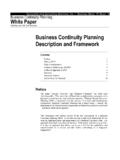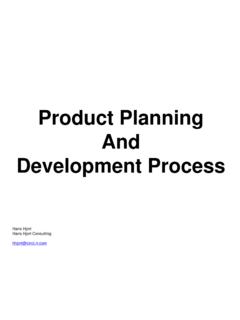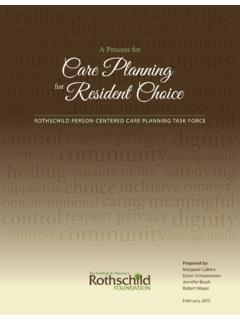Transcription of Disaster Recovery Planning - An Overview
1 Comprehensive Consulting Solutions, IncDisaster Recovery Planning An Overview . Business Savvy. IT Smart. White Paper Published: March 1999 (with revisions) An Overview of the Disaster Recovery Planning process - From Start to Finish Contents Preface 1 Overview 2 It s not just Computer Systems! 3 Typical Approaches to Disaster Recovery 3 Where do you start? 4 Understand the Business Goals and Objectives 4 Identify Specific Requirements 4 Identify Key Personnel 5 Identify Single Points of Failure 5 Preparing to Develop the DRP 5 The DRP should address 3 main functional areas 6 The DRP should address 3 main technical areas 6 Creating the Procedures that Support the Plan 7 Testing and Refining the Plan 8 A Project Management Approach 9 Summary 9 About the Author 10 Let Us Help You Succeed!
2 10 Preface Disasters happen. They can be small and straightforward to deal with, or if you re unlucky you can be faced with a full-blown catastrophe. We can t always avoid Disaster , but through diligent Planning and preparation we can minimize downtime and data loss. If your company relies on its IT systems to stay in business, then this white paper and the rest of the series on Disaster Recovery and Business Continuity Planning are a must-read for you! You can find those white papers at 2 Disaster Recovery Planning An Overview This white paper describes, at a high level, some of the many areas to address during the creation of a Disaster Recovery (DR) Plan.
3 It is not all-inclusive, but is intended to provide insight into the overall process and our approach. Overview Most businesses stay very busy working on projects that support the growth of that business. Many companies do not have a Disaster Recovery Plan (DRP). Often there is a desire for a DRP, but the level of effort and/or cost required to create a DRP can cause this project to have a low priority relative to other more immediate projects. A DRP is viewed as nice to have or just insurance that will not be used , and not as a critical business component. That is, until there is a failure that causes a significant outage or loss of data (often at a significant cost to the business).
4 It is our opinion that every company could benefit from both a Disaster Recovery Plan and a Business Continuity Plan (BCP). Companies purchase insurance to protect their business. Investing in a DRP and BCP is just as important for most businesses in our opinion. Are you able to quantify the cost of downtime for mission critical systems? Does this figure include lost sales and/or lost customers? Does it include the cost of wages for people unable to perform their primary job function while the system is down, as well as the amount of time required to get caught up once the system is available? Once a company quantifies the cost of unscheduled downtime the business case justification for a DRP usually becomes easy.
5 So, now that you have decided to go forward with this type of project, what next? Where do you start? What needs to be addressed? How will you know that the plan really works? Do you need to find external expertise for this type of project? If so, exactly what type of expertise is required? Before we go any further it is important to mention a few things. A DRP first needs to be created, then tested and refined, and finally implemented and tested on a periodic basis. While this can be an expensive and time-consuming effort, it can prove to be a bargain in the long run if some type of Disaster occurs. Most plans will experience some type of failure during their first execution so it is very important to test the plan.
6 Systems and personnel change, so it is also important to retest the plan on a periodic basis, ideally rotating staff. Using experienced Consultants to help develop the process and then later audit and refine the process is usually idea sound investment. They will often identify gaps or ambiguities that might have been missed by someone who has more familiarity with the systems, processes, and procedures in use. It is also important to find a team that will build plans based on how your business and systems work, and not try to make your business fit into a predefined template. Every business is different, and every system being recovered has its own nuances.
7 Being able to capture that knowledge is critical to success. An Overview of the Disaster Recovery Planning process - From Start to Finish 3 It s not just Computer Systems! It is also important to have a Business Continuity Plan. A BCP should address infrastructure related items that are often taken for granted. For example, where will people sit to do their job if there is a catastrophe? Where will mail be delivered? How will your customers find you? What type of workstation and software will be required? Are there phones, voice mail and e-mail? How will the outside world reach you? How will your site communicate with remote groups? Are there any special requirements required for day-to-day operations ( , websites, specialized machinery, secure remote access, broadband, etc.)
8 ? If this is a multi-site location, what is the plan if more than one site has a failure at the same time? These are all very important issues that need to be addressed for a comprehensive Disaster Recovery Plan. Please see our white paper on this subject for more information. Another related topic is Emergency Management and Communication. This deals with issues such as physical security of site, medical care, and coordination with Government Emergency Management teams, and communication with your management team, employees and vendors. Typical Approaches to Disaster Recovery Once a company recognizes the value of Disaster Recovery , the next question is generally how do we do it?
9 They may try it themselves at a remote facility with redundant equipment (a hot site ). They may secure the services of a DR facilities and services provider (generally a multi-year agreement that often starts at a cost of $250,000+ per year). Or, if they are very lucky and have computer facilities located in several geographic areas, they may try to implement some type of SAN (storage area network) or data replication mechanism. That is often the most expensive solution, but also can provide the fastest Recovery time (shortest Recovery time objective, or RTO) with the least amount of data loss ( Recovery point objective, or RPO), resulting in the lowest overall system Recovery objective (SRO or the point where the systems are ready to do real work).
10 When using a DR Facilities provider there are many issues to consider. It is likely that the equipment provided for Recovery during a test or an actual Disaster is not identical to the equipment used in production. There may be availability issues if the company has many customers in a single geographic area. There may be phone and network bandwidth issues if more than one customer declares a Disaster at a single time. Does the company have multiple hot sites that you can use? Where are they located? How long would it take to assemble a Recovery team at each site? (This affects the RTO) How often can you test the plan (twice a year is ideal), and how long will you have to test the plan (24-72 hours is typical)?









